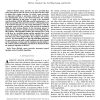Free Online Productivity Tools
i2Speak
i2Symbol
i2OCR
iTex2Img
iWeb2Print
iWeb2Shot
i2Type
iPdf2Split
iPdf2Merge
i2Bopomofo
i2Arabic
i2Style
i2Image
i2PDF
iLatex2Rtf
Sci2ools
133
Voted
JSAC
2010
2010
Simple movement control algorithm for bi-connectivity in robotic sensor networks
Robotic sensor networks are more powerful than sensor networks because the sensors can be moved by the robots to adjust their sensing coverage. In robotic sensor networks, an important problem is movement control: how the robots can autonomously move to the desired locations for sensing and data collection. In this paper, we study a new movement control problem with the following essential requirements: i) an initial and possibly disconnected network is self-organized into a bi-connected network, ii) only 1-hop information is used for movement control, iii) the coverage of the network is maximized while the total moving distance in the movement process is minimized. We propose a simple movement control algorithm for this problem. This algorithm emulates the attractive force (such as the force in a stretched spring) and the repulsive force (such as the electrostatic force between electric charges) in nature, such that each robot simply follows the resultant virtual force to move. We the...
Related Content
| Added | 19 May 2011 |
| Updated | 19 May 2011 |
| Type | Journal |
| Year | 2010 |
| Where | JSAC |
| Authors | Hai Liu, Xiaowen Chu, Yiu-Wing Leung, Rui Du |
Comments (0)

